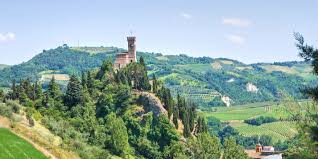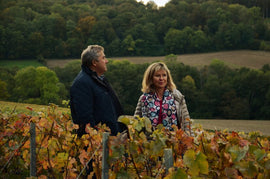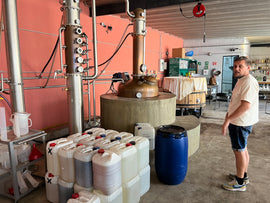Emilia! Romagna!
Italy is so famous for both vino production (#1 in the world officially), and the veneration of very old stuff (less quantifiable, but only b/c there are too many museums and ruins to count), that it’s easy to forget that Italians didn’t actually invent wine. While a few places - China, Georgia, Armenia, - have stronger claims to the title, the truth is that no one knows when or where this most ancient tipple first appeared on the scene. In fact, the more we learn about it, the older and less certain its origins become. The interesting question is whether it is even possible for anyone to take credit for fermented grape juice. Can wine actually be invented, or only discovered? A little of both? And what are the implications of the answer?
Obviously this is all well outside the usual Italian Wine Club purview, but since our wines this month are from Emilia Romagna, and we were there just this past March, I thought I’d forgo the usual regionally specific trivia in favor of a slightly wider focus. We don’t have nearly enough space here to cover, answer or even adequately address the above questions but it’s all important context to ponder or ignore as you pop these bottles and wonder how they came to be. So let’s start with the ”Drunk Monkey” hypothesis.
While we know for sure that wine precedes agriculture and the domestication of grapes, it's also possible it predates humanity, full stop. Fermentation is a natural process: when grape skins are broken, yeast interacts with the sugars present, initiating fermentation and eventually producing alcohol. In the early 2000s, integrative biologist Robert Dudley posited that primates were enjoying the juice of fermented fruit for millions of years before humans showed up, attracted by the easier to ID and locate smell of fermenting fruit. This wouldn’t have been grape wine (no grapes in sub-Saharan Africa then) but an important harbinger nonetheless to the unrecorded moment when roving humans in Eurasia came upon some wild grapes, placed them in their woven baskets (no ceramics yet), crushing the ones on the bottom, and thus producing juice that fermented in the warm weather. This scenario, known as the Paleolithic hypothesis, is largely supported by anthropologists and, while we can’t say for certain that this is how it happened, if so, it definitely would’ve qualified as “natural wine,” wherever you stand on that whole debate.
We are on more solid footing when it comes to dating the domestication and cultivation of grape vines, which required permanent human settlement and, for the making of wine year round, the invention of airtight ceramic vessels. The oldest yet unearthed example comes from the Neolithic period, around 6000 B.C., in what is today the Republic of Georgia. This is notable both because Georgia still has a robust winemaking culture today, and the methodology for which it is most famous is quite similar: most Georgian wine is made in qvevri (egg shaped clay containers) buried in the ground to ferment. This was, more or less, the way most ancient grape juice got fermented and stored, known as Anfora in Italy, Tinaja in Spain, Talha in Portugal, or Karas in Armenia. It wasn’t until thousands of years later that wood barrels came into fashion, followed by stainless steel and concrete.
Recently, more winemakers have been going back to the use of these clay containers, including our white producer this month, Tre Monti. Some of you may remember them from the September 2022 club, when we featured their Sangiovese ‘Thea.’ We love all their wines, and I have been waiting for an opportunity to feature their most unique offering, the Vitalba. Made from 100% Albana, an indigenous grape, it spends 70 to 120 days macerating on its skins in qvevri/Anfora, which preserves the varietal characteristics, maintains a steady temperature for slow fermentation and adds weight and texture without the need for oak treatment. The result is a vivid, textured and well balanced orange wine to convince skeptics and impress enthusiasts alike.
The red is also somewhat of a “natural” production, a blend of the well-known Barbera varietal (a staple of Piedmontese bottlings) and a grape called Bonarda that is, quite confusingly, entirely different from the Bonarda grown in Argentina, which is actually a varietal originally from France called Douce Noir (or Charbono if you’re in California). Northern Italy’s version (also known as Croatina) is frequently blended with Barbera in this area to add weight and aromatics.
Salut!
Alan Hicks - Wine Buyer
|
Tre Monti Vitalba Albana in Anfora Romagna 2022 |
|
|
Region: Romagna Trebbiano DOC, Italy |
About the Winery: This 30-hectare estate located in the hills of Imola overlooking the Romagna plain specializes in the three local varietals: Albana, Trebbiano, and Sangiovese. The viticulture here is currently sustainable, and the estate is incorporating biodynamic principles more and more. Soil types are mainly sandy clay with small pebbles, which seem to be ideal for producing the crisp mineral white wines that this estate is known for. Cool nights and hot days are ideal for ripening both the Albana and Trebbiano vineyards. The winemaking operations are watched over painstakingly by the experienced and talented Vittorio Navacchia, and animated by a philosophy of minimal intervention. Every step is carried out with full respect not only for the integrity of the fruit, but above all for the unique character of each growing year, so that Vittorio can ensure that the final wines fully expresses all of the conditions that gave it “birth”. About the Winemaking: Vinification In Georgian amphora (kvevri) of 470 liters without addition of selected yeasts and without temperature control. Maceration: from 70 to 120 days (depending on the year) 2500 bottles avg. annual production. Tasting Notes: Truly an orange wine, this has a copper hue with honeyed notes of stone fruit, citrus and almonds. Silky in texture on the palate, it is nonetheless very persistent and shows great complexity. |
|
Winemaker: Mario Cirese |
|
|
Price per bottle / Price per case $37.99 / $410.30 |
|
|
Suggested Food Pairing: Pumpkin Ravioli (see recipe) Cured meats Halibut or other white fish Lentil Stew Green Curry |
|
|
La Stoppa Trebbiolo Rosso 2022 |
|
|
Region: Vino Rosso IGT |
About the Winery: La Stoppa is a 50 hectare property located in northwest Emilia-Romagna. Founded in the late 19th century by a wealthy lawyer named Gian Marco Ageno, the estate is currently run by Elena Pantaleoni and head vignaiolo Giulio Armani. Today, the wines produced from La Stoppa are typically Emilian. but this wasn't always the case; moving forward occasionally means taking a step back. In 1996, Elena and Giulio decided to replant the entirety of their estate in Barbera and Bonarda, both typical and suited grapes for the region. Interestingly, the prior owner had taken post phylloxera replanting as an opportunity to experiment with noble grapes from around the world which, amongst others, included Chardonnay, Sauvignon Blanc, Pinot Noir, Tokay and Pinot Gris. The estate has been worked organically since the early 1990's and certified in 2008. All the wines are fermented in stainless steel and concrete vats, then racked to a variety of small and large oak barrels for aging. The wines ferment off of their native yeasts and nothing is ever added or subtracted from the juice. Sulfur is never added during vinification or bottling, save a tiny amount for the entry-level wine "Trebbiolo". Because of the region's warm climate, Giulio prefers long skin contact to extract as much as possible. About Winemaking: 70% Barbera/30% Bonarda (aka Croatina, not Bonarda from Argentina). Trebbiolo is generally made from the younger, more productive vines at La Stoppa. They lie down the hill on which the winery sits, below the older hilltop vines that produce La Stoppa's long-aged La Macchiona; the flatter area has heavier soils and produces bigger berries. The farming is certified-organic and the harvest by hand. The bunches are destemmed, gently crushed and fermented with native yeasts in stainless steel and concrete tanks; maceration with the skins lasts around 20 days. The wine is aged in tanks and released generally the summer after the vintage. Tasting Notes: “Masses of crushed raspberries mix with wild herbs, dried roses and hints of underbrush as the 2019 Vino Rosso Trebbiolo opens up in the glass. It’s soft and round in feel yet bristling with energy as vibrant acids enliven its crisp red and blue fruits. Sweet spices, zests of citrus and hints of mint form toward the close as this tapers off nicely refreshing with medium length. You’d be hard-pressed to stop at just one glass.” - Vinous |
|
Winemaker: Guilo Amrani |
|
|
Price per bottle / Price per case $26.99 / $291.50 |
|
|
Suggested Food Pairing: Pumpkin Ravioli (see recipe) BBQ meats or tofu Pizza Pasta dishes with tomato sauce Eggplant Parmesan |
|
Tortelli di Zucca (Pumpkin Ravioli)
Ingredients
For the filling: 1. 615 g pumpkin puree approx from ½ a medium pie pumpkin 2 . 55 g parmesan (2 oz = approx ⅔ cup) - highly recommend real parmigiano reggiano 3. ⅛ teaspoon nutmeg 4. 1 pinch salt
For the pasta dough: 1. 3 eggs 2. ½ teaspoon salt 3. 280 g flour 4. 1 tablespoon olive oil
To serve: 1. 58 g butter (more/less to taste) 2. 8 sage leaves
Instructions
To prepare the pumpkin
- You can use canned pumpkin or half of an approx 4-5 lb (1.8-2.2.kg) pumpkin, (cut in half and seeds and soft stringiness removed from the inside). Preheat the oven to 400F/200C. Place the cleaned pumpkin half cut side down on a baking sheet/tray and roast for approx 30 minutes until the skin is darkening and it is soft to touch. Leave to cool before scooping out the flesh and mashing or blending to a smooth puree.
For the pasta dough
- To make the pasta, put the eggs and salt in a food processor and pulse until broken up and mixed. Add approximately half the flour and the olive oil then pulse a few times to combine. Add the rest of the flour and pulse a few more times to mix and until the dough comes together, away from the sides into a ball, or at least into large crumbs.
- Remove the dough to a floured surface and knead with floured hands for a couple minutes. It should be slightly soft but not sticky. Note it will be firmer than a typical pasta dough.
- Wrap in plastic/cling film and allow to rest at room temperature for around 30 minutes. At this stage, you can keep the dough in the fridge for a day or two until ready to use.
For the filling
- Mix together the pumpkin puree, grated parmesan and nutmeg until well blended. Set aside to use as you roll and fill the dough.
To Form Ravioli & Serve
- When ready, divide the dough into 6 pieces and cover the pieces you aren't working with with a damp cloth or the cling film to save them drying out. Prepare some trays by dusting them with flour.
- As you work with each piece, flatten it out slightly, dust with flour then put it through your pasta roller on the widest settings a few times (about 2-3 should be fine) until smooth. Dust with flour in between if at all sticky. Then move up the settings, rolling once or twice at each setting until you get to the thickness you would like - I usually go to around 6 on my pasta maker. It should be very thin but not breaking up.
- If using a ravioli mold, lay the sheet of pasta over a ravioli mold then press down the frame to make indents. Fill each with a teaspoon of filling.
- Lightly dampen around the edges of each ravioli with a little water then roll another pasta layer to place on top, or fold over the rest of the piece you have if it is long enough, trying to avoid any air getting in each one. Press down with a rolling pin to seal then trim the excess pasta from around the side of the mould and add to a piece to use later. Carefully remove each ravioli from the mold and lay them on the floured trays.
- If not using a mould, you can make them by laying the first piece of pasta out, dotting teaspoons of filling out evenly in lines with gaps between, dampening between then laying another layer on top. Then gently press in the areas between the filling to seal and cut.
- Repeat with the rest of the pasta and filling. Once all the pasta has been used and you are ready to cook, place a few ravioli at a time in a shallow pan of boiling water for around 2-3 minutes until they rise up to the top, then remove with a slotted spoon and cook the rest in batches. Serve with simple brown sage butter warm approx ½-1 tbsp (7-15g) butter per person with a couple sage leaves in a small skillet until you can see it brown slightly and the smell becomes nutty. Drizzle over the top of the cooked ravioli.





